|
 Dispersion Dispersion
means, that the
| index of refraction n depends on the frequency.
|
or
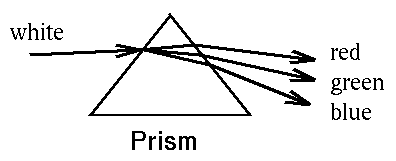
| RED |
ORANGE |
YELLOW |
GREEN |
BLUE |
VIOLET |
| 700 nm | |
600 nm | | |
400 nm |
Remember: 1 nm = 10-9 m
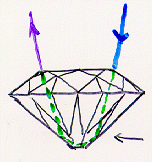
Diamond has a large index of refraction, n about 2.4,
so the critical angle for internal reflection is about 24.5
deg, much smaller than that for glass. This accounts
for the brilliance of diamonds.
A diamond is cut so that almost any ray of light that hits it from
the front strikes one of hte rear surfaces at an angle greater
than 24.5 deg, is internally reflected to anther surface, and
eventually is reflected back out the front. Viewed from the front,
the diamond is bright - brilliant. However, if you look from the back
through a cut diamond at a light source, the diamond will appear black,
almost no light passes through the back.
Index of Refraction
| Wavelength (nm) |
Color |
Diamond |
Glass |
Water |
| 656
| Red
| 2.410
| 1.571
| 1.331
|
| 589
| Yellow
| 2.418
| 1.575
| 1.333
|
| 434
| Deep Blue
| 2.450
| 1.594
| 1.340
|
Diamond is highly dispersive, the index of refraction
varies considerably with frequency (see table). The blue is
bent much more than he red, so white light is spread
out into a broad spectrum (much more than is the case for glass).
This accounts for the fire of diamonds, the colors.
You see in the following figure the photograph of a single light
beam falling on diamond. Watch the different colors of the spectrum
at the sides of the diamond.
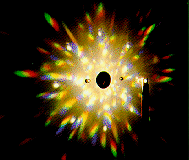
No matter how you look at a cut diamond, the chances are that you will get
rays reflected from some source of light in the room, and it will be
spread out into its spectral colors. As you move your eye slightly
or rock the diamond, the view changes and you see some other rays
that reach your eye by some other path. This causes the flash
of diamonds. The motion causes the diamond to sparkle as the light
reaches you from different sources.
It is important to note that the bending of light and total internal
reflection in diamond is due to the ratio of the index of refraction
of diamond to that of air: the greater the ratio, the greater
the refraction at a boundary.
 Rainbows Rainbows
Because of the dispersion of water, droplets of water can break up
the sun's light into a spectrum, much as a prism does. This accounts
for the rainbow. Its formation involves not only
dispersion of light on entering and emerging from the drop, but
internal reflection as well. The result is that the drop
reflects the sun's light, but the different colors emerge at
different angles since, for example, blue light is bent more than
red light. If you are to see both, red and blue light, these lights
must come from different rain drops; those reflecting red light
to your eye are at the higher angle, because red emerges more downward than
blue. Thus, the rainbow has red at the top (outside) and blue at
the bottom (inside), with the other colors in between.
Light beam from sun is dispersed twice and
reflected once by a raindrop, letting you
see a rainbow. (The dispersion is exaggerated in the figure below.)
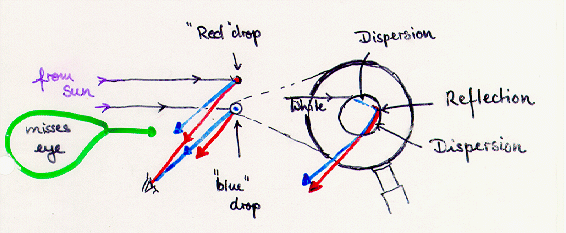
An entire arc of water drops will look red to your eye: all those
drops lying on a cone from your eye of about 42 deg around the
direction of the sun's rays. Similarly, drops along arcs at smaller
angles reflect other colors to your eye. The entire rainbow thus
appears as an arc ranging between 40 deg and 42 deg. Since this
angle is measured from your eye, it is your own private rainbow.
The light from these particular water drops reaches your eye,
and misses everyone else's. Others must see the light coming from
different drops, those at the appropriate angles from their eyes.
As you move your eye, the rainbow moves with you to maintain the
same angular relationship, it follows you as you move.
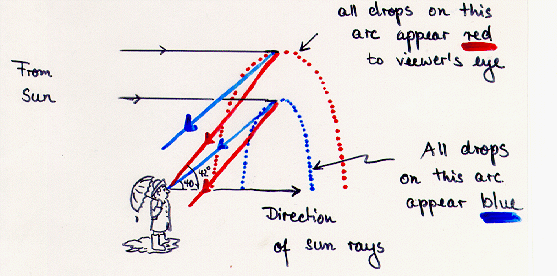
If you look at this photograph of a
rainbow you see the primary rainbow and a secondary rainbow.
 Secondary Rainbow
Secondary Rainbow
The secondary rainbow is caused by two reflections and two refractions
in each raindrop. The extra reflection reverses the order of the
colors.
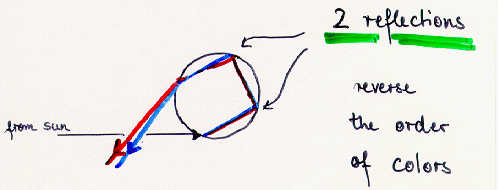
 Chromatic Abberation Chromatic Abberation
Glass is a dispersive medium, bending blue light more than red light.
If white light falls parallel on a glass lense it is being dispersed.
That means that the bleu and red light have different focal points, one
for blue light, Fb, and one for red light, Fr.
The other colors are focused between. If we place a screen at
Fb, we find a sharply focused blue dot surrounded by a halo of
the other colors. The largest halo is red. Moving the screen to
Fr produces a sharply focused red dot surrounded by a
halo of the other colors, with blue spread out the most. This
colored blurring is called chromatic aberration.
Such a lens in your camera would produce colored outlines on your
photographs. Even if you used black and white film, the incident
white light would be spread out into a blurred image. To correct for
this aberration, one uses an achromatic doublet: two lenses,
cemented together, and made of different kinds of glass to have different
dispersions.
Remark:
Mirrors do not exhibit chromatic aberration because the law of
reflection is the same for light of any color.
Chromatic Abberation - Digital Photography School
|




 Dispersion
Dispersion  Index of refraction n
Index of refraction n
 Blue has a
higher value of n than red.
Blue has a
higher value of n than red.  Dispersion
Dispersion  Spectrum
Spectrum  Diamonds
Diamonds  Rainbows
Rainbows 
 Secondary Rainbow
Secondary Rainbow
 Chromatic Abberation
Chromatic Abberation 